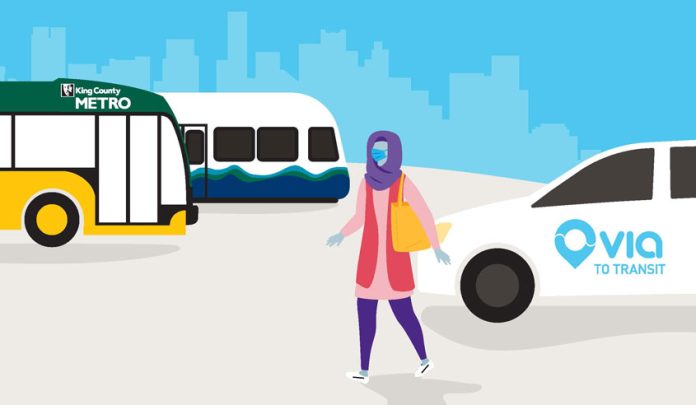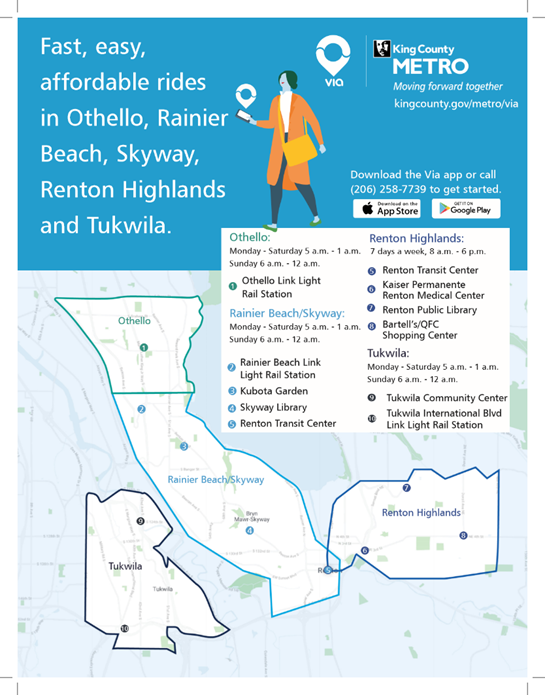King County Metro has announced that Via to Transit, an on-demand rideshare service, will expand to new areas and serve more “hubs” throughout Southeast Seattle, Renton, and Tukwila. The service expansion goes into effect today.
Launched as a pilot program in 2019, Via to Transit has allowed riders to book trips via a phone app or phone to travel to and from formal hubs and another location within specific service areas (each trip must end or begin at a hub). These service areas have traditionally been around light rail stations in Southeast Seattle and Tukwila. In fact, all three original hubs were located at Othello Station, Rainier Beach Station, and Tukwila International Boulevard Station — all Link light rail stations.
Via to Transit uses small vans for its service, including some specifically designed for wheelchair accessibility. The vans can also carry bikes and luggage, but riders are encouraged to limit personal items to one normal-sized luggage bag. New vehicles are planned to be hybrid electric and include bike racks.
Metro’s Via to Transit expansion adds a large slate of new hubs and expand the service area map by creating two new service areas. The expanded pilot program includes the following service areas and hubs:
- Othello with a hub at Othello Station. Service hours will be Monday through Saturday from 5:00am to 1:00am and Sunday from 6:00am to 12:00am.
- Rainier Beach/Skyway with hubs at Rainier Beach Station, Renton Transit Center, Skyway Library, and Kubota Garden. Service hours will be Monday through Saturday from 5:00am to 1:00am and Sunday from 6:00am to 12:00am.
- Renton Highlands with hubs at Renton Transit Center, Kaiser Permanente Renton Medical Center, Renton Highlands Library, and Bartell’s/QFC. Service hours will be Monday through Sunday from 8:00am to 6:00pm.
- Tukwila with hubs at Tukwila International Boulevard Station and City of Tukwila Community Center. Service hours will be Monday through Saturday from 5:00am to 1:00am and Sunday from 6:00am to 12:00am.
The new service hours will likely be an especially welcome change in Tukwila where Via to Transit only operated Monday through Friday 6:00am to 9:00am and 3:00pm to 6:30pm.
Riders can pay for Via to Transit trips using ORCA cards, a digital Transit GO Ticket, or other payment card by the Via app or call center. Fares cost the same price as riding the bus ($2.75 for adults, $1.50 ORCA LIFT and youth riders, $1.00 Regional Reduced Fare Permit holders, and free for children aged five and under) with free transfers when using an ORCA card or Transit GO Ticket.
Metro boasts that the fledgling service carried nearly 800 riders per day in its first year and had a very high satisfaction rate among customers (4.8 out of 5 stars). The agency has also highlighted how its Via to Transit pilot program is focused on historically disadvantaged and underserved communities.
“Via to Transit will serve some of the most diverse neighborhoods in the county; 66% of residents are Black, Indigenous, or other people of color, 37% were born abroad, and 45% speak a language other than English at home,” the agency said in a statement. “Metro’s Mobility Framework — which helps the agency adapt to the changing transportation landscape in an equitable and sustainable way — identified these core neighborhoods as areas of opportunity due to their difficulty to serve with fixed-route services, and high unmet need for affordable access to public transit. Metro has worked closely with these communities to understand their needs. Residents have expressed strong support for an on-demand flexible service and have helped identify which community and transit hubs are most important to serve to increase access.”
However, a new report does pour some cold water on the pilot program. In 2020, the report suggests that only about 5% of light rail riders used Via to Transit as a first-/last-mile solution. Racial makeup of ridership was decidedly White based upon two surveys with over 47% to 58% of riders identifying as White versus 32% in the census, meaning a big overrepresentation by Whites using the service. Ridership among low-income riders also did not significantly improve much over the status quo with the report concluding that “while the pilot project included a number of features intended to increase access to transit to groups with disadvantages, the Via service did not appreciably increase use of Link by those communities.”
On top of this all, Via to Transit may be peeling off some riders who might otherwise take the bus to connect to light rail. “Roughly one-quarter of Via users reported having previously used a bus to access and egress Link stations,” the report states. “The shift of those individuals to Via appears to have resulted in a decrease in bus transit use at the bus stops nearest the Link stations, as well as a decrease in transfer activity at those locations.”
Nevertheless, the report authors had a cautious outlook on Via to Transit: “…the evaluation team concludes that the Via service appears to have had a positive effect on Link ridership. However, the available data did not prove that Via actually increased Link ridership, as other factors appear to have had a larger impact on Link ridership than the improved access to Link stations provided by the Via service.”
The report’s findings should push policymakers to continue closely monitoring and evaluating the pilot program to adjust it and carefully consider its fate in the future. So far, it’s not clear that Via to Transit is accomplishing much of anything better on the ridership front than fixed-route transit and paratransit service could provide — even if there are indeed riders who benefit from the Via to Transit service with a better first-/last-mile option. While a completely different approach, Metro’s additional bus service investments in historically disadvantaged communities during the pandemic have provided decidedly good ridership outcomes, for instance, leading the agency to keep the changes. That goes to show just how much a basic focus on frequency and span of service can do in keeping and garnering riders. Suffice it to say, the cost of Via to Transit service is still quite expensive, so good stewardship of transit funding resources ought to remain a priority as well as achieving equity objectives as the pilot program moves forward.
Stephen is a professional urban planner in Puget Sound with a passion for sustainable, livable, and diverse cities. He is especially interested in how policies, regulations, and programs can promote positive outcomes for communities. With stints in great cities like Bellingham and Cork, Stephen currently lives in Seattle. He primarily covers land use and transportation issues and has been with The Urbanist since 2014.



